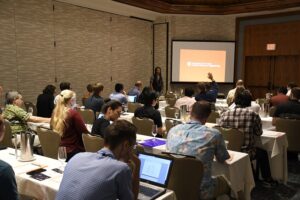
Moriba Jah provides a foundation for SSA and STM in his technical short course.
Ten (10) Short Courses, taught by high regarded industry experts, have been selected to run on September 17 at the AMOS Conference. Topics address space surveillance, conjunction assessment, optical systems, genetic algorithms, machine learning and more.
With five running concurrently in the morning, and five in the afternoon. the short courses provide an opportunity to upgrade technical job skills and remain abreast of recent development in fields of interest. Separate registration fee is required for each course.
SHORT COURSE SCHEDULE – September 17, 2019
8:00 AM – 12:00 PM TECHNICAL SHORT COURSES 1 – 5
1. CA Risk Assessment
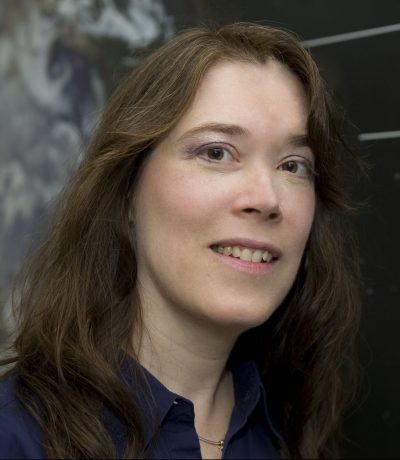
Lauri Newman, NASA
Presented by:
Francois Laporte, CAESAR team leader, CNES
Matt Hejduk, Chief Engineer, Astrorum Consulting LLC
Lauri Newman, Senior Engineer, Goddard Space Flight Center – NASA
The threat of on-orbit collisions has become an increasing concern to the spacefaring community, both as an increasing mission risk due to a more congested space environment and through wider community awareness of the problem. The operational practice of conjunction assessment in response to this risk has also become more commonplace, evolving from simply predicting close approaches between orbiting objects to sophisticated systems and processes for managing on-orbit collision risk. This short course, organized and taught by industry leaders and subject matter experts in the field, is designed to educate beginners to intermediate-level practitioners on the fundamentals of conjunction assessment.
This course provides a three-part overview of Conjunction Assessment. The first part is an extended background theory section that includes all the theoretical components which are needed in order to perform conjunction analysis and associated risk assessment. Topics include relevant astrodynamics basics, orbit determination methodologies, space situational awareness basic concepts, and satellite conjunction assessment theory. New subjects for this year include quantified limitations of the two-dimensional probability of collision calculation, Monte Carlo analysis, cross-correlation between satellite co-variances, and collision consequence assessments.
The second part of the course contains a treatment of modern conjunction risk assessment practices. The presenters share their operational experience and lessons learned, including some historical collision and close approach prediction statistics. Topics in this section include using and interpreting satellite probabilities of collision, designing and evaluating collision risk mitigation maneuvers, and understanding and processing the various relevant conjunction assessment data products, including those provided by the 18th Space Control Squadron.
Altogether, over 170 satellites are supported by either the NASA Conjunction Assessment Risk Analysis (CARA) or the CNES Conjunction Assessment and Evaluation Service: Alerts and Recommendations (CAESAR), two instance of Middle Man. For both Middle Man examples, operations methods are presented and feedback is discussed. Both organization’s processes regularly evolve in order either to follow 18th Space Control Squadron upgrades or to improve analysis according to operational experience acquired during the past years.
The third and final section of the course contains a treatment of emerging technical and policy challenges for conjunction assessment activities. The space environment has been rapidly evolving, and is expected to continue to do so in the coming years. These changes include:
- Many companies are proposing very large constellations
- Cubesats are making space accessible to non-traditional space operators
- Regulation and best practices are evolving
- Efforts continue to define an architecture for a consolidated governmental or international Space Traffic Management (STM) entity
- The incipient deployment of the Air Force’s Space Fence radar is expected to greatly increase the number of catalogued space objects
This course not only demonstrates that Collision Avoidance is a 2-step process (close approach detection followed by risk evaluation to enable making a sound collision avoidance decision) but also leads to the conclusion that the complicated topic leads to the need for an experienced Middle Man role to provide expert advice to spacecraft operators. This course would be presented jointly between Centre National d’Etudes Spatiales (the French Space Agency) and the NASA Conjunction Assessment Risk Analysis team.
2. Space Debris Risk Assessment and Mitigation Analysis – Verification of compliance with requirements on space debris mitigation using ESA’s upgraded DRAMA and MASTER software
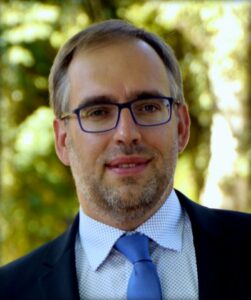
Tim Flohrer, ESA
Presented by:
Tim Flohrer, Senior Space Debris Monitoring Analyst, ESA/ESOC Space Debris Office
Francesca Letizia, Space Debris Engineer, IMS Space Consultancy GmbH @ ESA – European Space Agency
For more than twenty years, the Inter-Agency Space Debris Coordination Committee (IADC), which is represented by space agencies from thirteen member states, has been coordinating space debris mitigation activities. IADC guidelines were the basis for space debris mitigation requirements that became applicable to space missions, e.g., conducted by NASA or ESA, but also found their way into national space law, for example in France. In order to verify that these requirements are met, we rely on the use of qualified tools. In view of the increasing number of parties involved in launching and operating spacecraft, qualified tools establish the means to assess the mitigation-related aspects of the mission design in an early project phase, and to compare them to results obtained for other missions and designs.
The objective of this course is to provide an elementary introduction to ESA’s corresponding tools that are provided as a collection in the Debris Risk Assessment and Mitigation Analysis (DRAMA) tool suite, and through ESA’s Meteoroid and Space Debris Terrestrial Environment Reference (MASTER). These tools will enable the participants to perform the required mitigation and risk analyses in order to verify the compliance of mission scenarios with space debris mitigation requirements. DRAMA and MASTER have been upgraded recently to DRAMA-3 and MASTER-8 and are available from ESA for users worldwide subject to a registration, and free of charge.
3. Demystifying Machine and Deep Learning Neural Networks

Joe Coughlin, L3 Harris
Presented by:
Joseph Coughlin, Senior Aerospace Systems Engineer, L3 Harris
Rohit Mital, Chief Technology Officer, Stinger Ghaffarian Technologies
Weston Faber, Aerospace Engineer, L3 Applied Defense Solutions
Operators and analysts are being overwhelmed with the amount of data available from both existing and new classes of sensors. When multiple sensors are combined in a network, the magnitude of the data becomes too great to analyze by conventional means. Machine Learning has been proposed as a solution to “big data” problems which will enable analysts to evaluate and determine courses of action based on information. A lot of misinformation surrounds Machine Learning and its potential to solve SSA problems. This short course builds upon the course given last year by further delving into Machine Learning and Deep Learning techniques to solve potential problems of interest to AMOS participants.
This course presents both an overview of current technologies and software and hardware architectures as well as crucial details on Machine Learning algorithms for aspiring or current users so that they can utilize Machine Learning and Deep Learning techniques in their exploitation of existing data. A key aspect of this course is the discussion of how and when Machine Learning is applicable. An overview of emerging technologies in Machine Learning and Artificial Intelligence, such as Explainable AI, will also be presented. Although many of the cases presented deal with the exploitation of optical data, the techniques can be applied to other data types as well. Although many of the cases presented deal with the exploitation of optical data, the techniques can be applied to other data types as well.
4. Theory and Application of Multi-Objective Optimization Using Genetic Algorithm
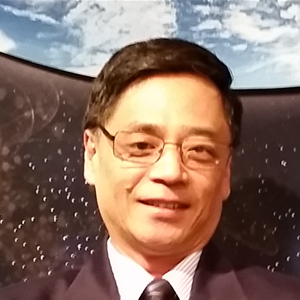
Triet Tran, Cornerstone Consulting LLC
Presented by:
Triet Tran, Senior Aerospace Consultant, Cornerstone Consulting LLC
Most real-world optimization problems are multi-dimensional in both the search space and the objective space. A familiar example is in the area of financial investment where the objectives are to minimize investment risk but at the same time maximize investment return in which the search space is the wide variety of investment instruments and the financial asset to be allocated to the specific investments. The same can be said about the domain of Space Situation Awareness (SSA). With limited tracking assets to track increasing number of Resident Space Objects (RSOs), the scheduling objectives could be to maximize the usage efficiency of all the tracking assets while achieving an acceptable level of orbital state accuracy for all RSOs to support catalog maintenance.
These are complex optimization problems and cannot easily be solved using traditional methods. Genetic Algorithm has seen significant growth for the past 15 years with respect to multi-objective optimization. Genetic Algorithm is a modern heuristic search algorithm based on the concept of “survival of the fittest” borrowed from the theory of biological evolution.
According to this theory, individuals within a population will have a better chance of survival if their attributes are most “fit” for the particular pressure of the environment. As “elite” individuals are selected to continue to survive while less fit individuals are allowed to “perish”, elite individuals are allowed to mate and generate children. The next generation are then evaluated with the same pressure of the environment as their parents. Better fit children are then selected while less fit children are discarded. The “breeding” and “selection” process continues until a convergence condition is met where, for example, a number of generational cycle is reached or the objectives cannot be improved with additional processing. The fundamental building block of GA is the genetic makeup on an individual within a population. Uniqueness of an individual is defined by the “genes” arranged in a particular order. Mating between two individuals involves exchanging the genetic sequence between them to generate one or more “new” individuals called “children”.
This course will present the key concepts of genetic algorithm as applied to multi-objective optimization. The algorithm will be explained in details including the concepts of multi- dimensional search space and multi-dimensional objective space. Hands-on exercises will be used to provide the students with a feel for how the Genetic Algorithm works. Applications of the multi- objective optimization to the problem of resource allocation will be demonstrated live in class. The presenter will show how the problem of tracking resource utilization for SSA can be addressed with this modern optimization technique.
5. SSA Optical Systems Modeling and Simulation
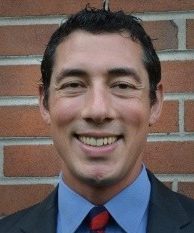
Patrick North, AGI
Presented by:
Patrick North, Chief Remote Sensing Engineer, Image and Computer Scientist, AGI
This course will be presented by a career Image Scientist who will present and discuss the methods and tools available for the modeling and simulations of SSA optical sensor systems. This will include a rigid radiometric review covering the mathematics and physics involved in electromagnetic radiation from the blue through the longwave thermal infrared. We will then discuss modeling the target characteristics, solar and secondary illumination sources, atmosphere and background modeling, and sensor simulation.
We will cover the different modeling and simulation methods, discuss their varying levels-of-fidelity and performance consideration, and assign the use-cases where each method would be most appropriate. During the course we will demonstrate the impact of different target, atmospheric, background, and sensor characteristics on imaging data and the downstream ramifications on image analysis and exploitation. Finally we will present various research level imaging concepts from novel hypothetical hardware, collection, and processing methodologies to capturing unique SSA collection opportunities and discuss the flexibility required to represent them in modeling and simulation.
1:00 PM – 5:00 PM TECHNICAL SHORT COURSES 6-10
6 . Statistical Orbit Determination for Space Surveillance and Tracking

Moriba Jah, The University of Texas at Austin
Presented by:
Moriba Jah, Associate Professor, The University of Texas at Austin
There is a growing number of Resident Space Objects (RSOs) in Earth orbit, especially given a new space race driven mostly by commercial actors. Space Traffic Management (STM) has become a salient topic with challenging problems to solve and no definite solutions in sight. Part of what is needed, is the ability to confidently and reliably detect, track, identify, and characterize RSOs. Space Surveillance and Tracking (SST) is a major pillar of Space Situational Awareness (SSA) recognized as such the world over. This short course will focus upon providing the student with an overall understanding of the various components of statistical orbit determination within the context of SST for SSA.
At the conclusion of this course, each student should be able to:
- Describe the basic history and purpose of statistical orbit determination
- Describe the effects and impacts of the space environment on space object motion
- Describe a model for the following observables: range, Doppler/range-rate, angles (e.g. az-el)
- Understand what is Astrodynamics and what is involved in propagating and simulating orbital trajectories under a variety of perturbations
- Understand what is involved in estimating the trajectory of a Resident Space Object (RSO) from a variety of tracking and/or inertial measurement unit data
- Understand how one can refine the trajectory solution by estimating for various model parameters and making appropriate corrections
- Understand and describe a variety of OD strategies to successfully determine the cause of observed phenomenology in observable data
Knowledge, Skills, and Abilities Students Should Have Before Entering This Course: The standard math and physics background for college science and engineering students is assumed.
Knowledge, Skills, and Abilities Students Gain from this Course (Learning Outcomes): Students will gain a general understanding of the overall Orbit Determination process and the analytic methods that are used to obtain trajectory solutions. Students will receive a working knowledge of OD terminology, the achievable levels of trajectory accuracy, and the most common error sources.
Return to Schedule
7. Observing and Characterizing Space Debris
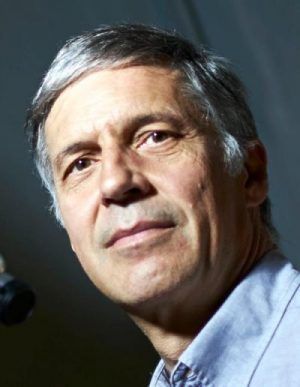
Thomas Schildknecht, Astronomisches Institut Universität Bern
Presented by:
Thomas Schildknecht, Vice Director, Head Optical Astronomie, Director Zimmerwald Observatory, Astronomisches Institut Universität Bern
The proliferation of space debris and the increased probability of collisions and interference raise concerns about the long-term sustainability of space activities, particularly in the low-Earth orbit and geostationary orbit environments. During recent years governments, space agencies and civilian research organizations increased their efforts to build space object catalogues and to investigate the space debris population in different orbit regions. Understanding the nature and the sources of debris is a prerequisite to provide the scientific foundation for a sustainable use of near-Earth space.
This course will provide a general introduction to the space debris problem, give an overview on the current space debris research activities to detect and characterize space debris, followed by a presentation of the efforts to model the future space debris population and the international efforts to protect and remediate the space environment. Particular focus will be put on optical techniques to detect, track and characterize space objects including small-size debris. The techniques will be illustrated with examples from the long-standing observation programs of the Astronomical Institute of the University of Bern (AIUB).
8 . Deep Learning for Space Situational Awareness
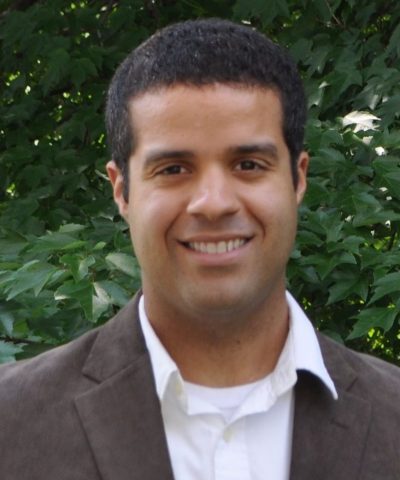
Richard Linares, MIT
Presented by:
Prof Richard Linares, Charles Stark Draper Assistant Professor, Massachusetts Institute of Technology
Robert Furfaro, Associate Professor, University of Arizona
Over the past decade, the field of machine learning has experienced incredible improvements in the applicability and accuracy of its techniques. These advances present huge opportunities for the SSA community as it faces ever-increasing scope, sensing modalities, and data volumes.
The short course will survey recent advances in machine learning and associated applications to SSA. The first portion of the course will cover a broad overview of modern machine learning techniques with an emphasis on those areas that seem most directly relevant to SSA. The second portion of the course will examine a set of case studies of the techniques being applied to real SSA problems, including code examples in MATLAB (neural networks toolbox/statistics and machine learning toolbox).
9. Telescopes and Optics for Ground-Based Optical SSA

Mark Ackermann, Sandia
Presented by:
Mark Ackermann, Systems Analyst, Sandia National Labs
Peter Zimmer, Astronomer, JTMA
This course will provide those new to the SSA community (as well as those seeking a refresher) an introductory-level understanding of the tools and techniques used for detecting and tracking earth-orbiting satellites with ground-based optical instruments. The course begins with an overview of optical telescopes and includes a discussion of many of the key terms and buzzwords one might encounter when reading about ground-based optical telescopes. From there, the course presents an overview of how these components are assembled into a sensor package for night time optical SSA and can be optimized to suit various mission goals. This includes a discussion of satellite visual magnitudes, terminator viewing, sensitivity, search rate and related topics. Finally, the course presents a brief look at the challenges and differences of optical systems for daytime optical SSA.
10. How to get the most out of Space-Track.org website and its API
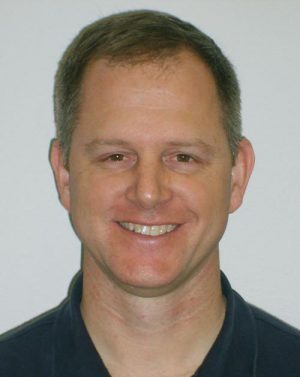
Robert Wooldridge, SAIC
Presented by:
Robert Wooldridge, Principal Software Systems Engineer, Science Applications International Corporation (SAIC)
Space-Track.org is the United States’ Joint Force Space Component Commander’s (JSFCC) Space Situational Awareness (SSA) Data Sharing website that promotes spaceflight safety, protection of the space environment, and sustainable, peaceful use of space worldwide. It does this through sharing space situational awareness services and information with U.S. Government entities, international satellite owners/operators (O/Os), academia and other entities.
This half-day Short Course will be part presentation and part workshop. The first portion will orient the SSA community to the data and services that space-track.org hosts, including little-known features of the website, and then I will spend the remainder of the time working with the course attendees in a workshop or “lab” setting, helping them use space-track’s powerful Application Programming Interface (API) to return exactly the spaceflight safety data that they need in the most efficient manner possible.
You can register, or add short courses to an existing registration HERE.
